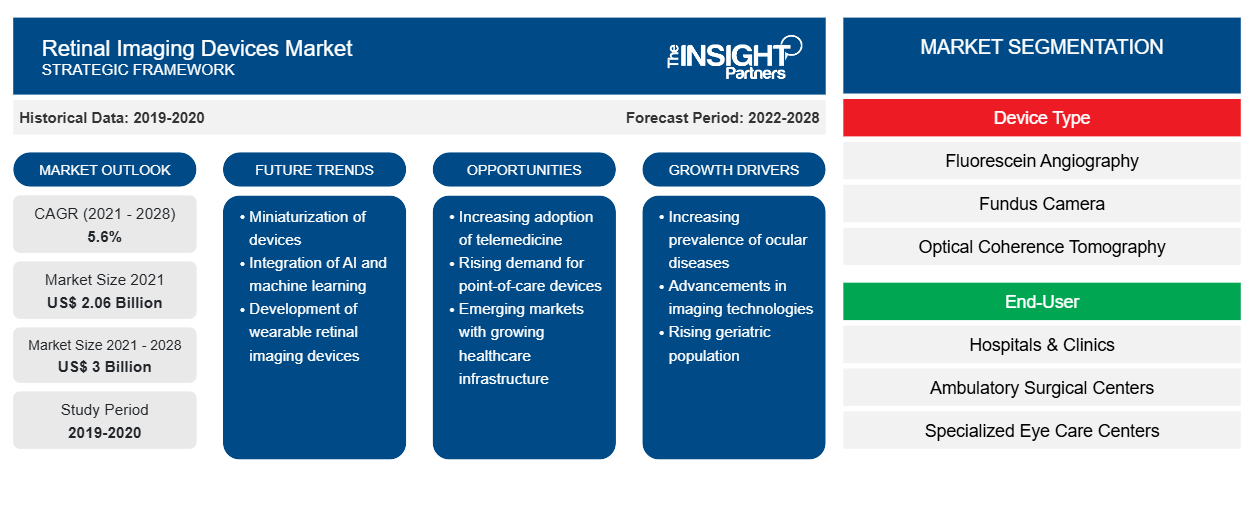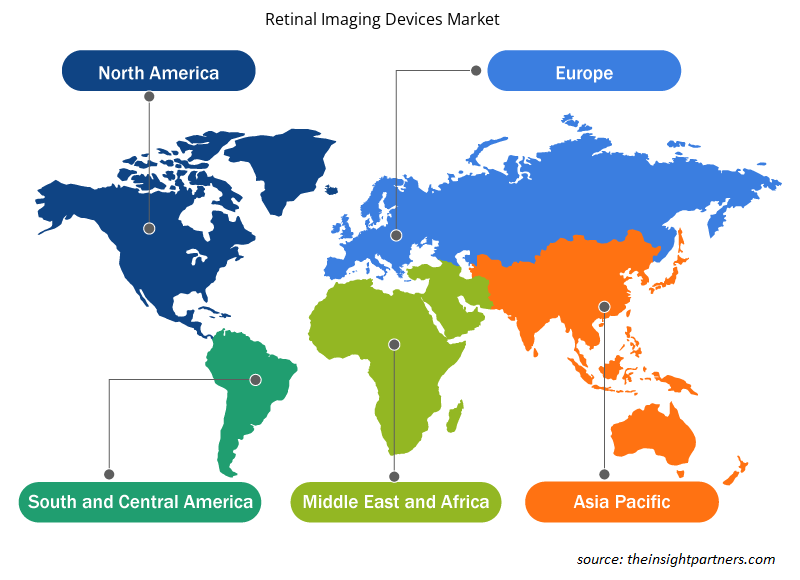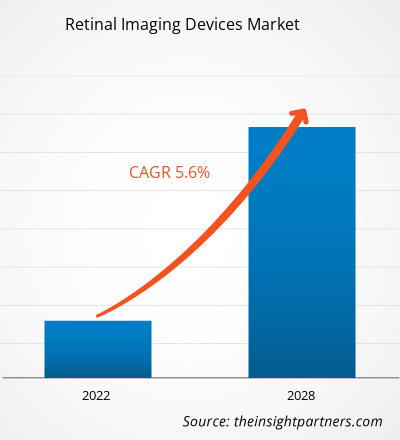The retinal imaging devices market is projected to reach US$ 3.00 billion by 2028 from US$ 2.06 billion in 2021; it is estimated to grow at a CAGR of 5.6% during 2021–2028.
Retinal imaging is a technique that is used to analyze and diagnose the condition of a patient's retina. Retinal imaging devices (RID) use high-resolution imaging systems to capture inside pictures of an eye. The captured image helps Virtual Private Network (VSP) network doctors assess the health of the retina, which helps in the detection and management of eye and health conditions such as diabetes, glaucoma, and macular degeneration, amongst others.
Customize This Report To Suit Your Requirement
You will get customization on any report - free of charge - including parts of this report, or country-level analysis, Excel Data pack, as well as avail great offers and discounts for start-ups & universities
Retinal Imaging Devices Market: Strategic Insights

- Get Top Key Market Trends of this report.This FREE sample will include data analysis, ranging from market trends to estimates and forecasts.
You will get customization on any report - free of charge - including parts of this report, or country-level analysis, Excel Data pack, as well as avail great offers and discounts for start-ups & universities
Retinal Imaging Devices Market: Strategic Insights

- Get Top Key Market Trends of this report.This FREE sample will include data analysis, ranging from market trends to estimates and forecasts.
The growth of the retinal imaging devices market is attributed to the improved ophthalmologists’ access to the retina, growing global initiatives for blindness and technological advancements. However, the high cost of OCT devices hampers the market growth.
Market Insights
Rising prevalence of eye diseases
Retinal imaging devices are widely used to diagnose and treat various eye-related diseases such as diabetic retinopathy, age-related macular degeneration, glaucoma, ocular melanoma, and mild vision problems. In addition, across the world, concern for blindness or vision impairment is growing significantly. According to the data published by the World Health Organization (WHO) in October 2021, nearly 2.2 billion people live with a vision impairment or blindness. Among which approximately one billion vision impairment cases can be prevented by proper diagnosis and treatment. These one billion people have different eye problems related to moderate or severe distance vision impairment or blindness. Image-related diagnostic technologies have begun to offer unprecedented growth into eye diseases based on morphological datasets. Such a factor is expected to aid the retinal imaging devices market over the forecast period.
Device Type-Based Insights
Based on device type, the global retinal imaging devices market has been segmented into fluorescein angiography, fundus camera, and optical coherence tomography. The fundus camera segment held the largest share of the market in 2021. Fundus photography has transformed from electronic flashes to smartphone-based cameras to a more recent portable eye examination kit (PEEK). PEEK is a smartphone-based application for a comprehensive eye examination. The advantage of these cameras is that a non-ophthalmologist can take pictures and, with some training, grade them as well. However, the optical coherence tomography segment is anticipated to register the highest CAGR of 8.1% in the market during the forecast period. The optical coherence tomography allows the evaluation of different levels of macular ischemia that are not diagnosed in primary imaging. The technique is used as a standard for imaging modalities for eyes.
End-User-Based Insights
Based on end-user, the global retinal imaging devices market is segmented into hospitals and clinics, specialty clinics, ambulatory care centers, and others. The hospitals & clinics segment held the largest share of the market in 2021 and specialized eye care centers is expected to register the highest CAGR of 6.6% in the market during the forecast period.
Retinal Imaging Devices Market Regional Insights
The regional trends and factors influencing the Retinal Imaging Devices Market throughout the forecast period have been thoroughly explained by the analysts at The Insight Partners. This section also discusses Retinal Imaging Devices Market segments and geography across North America, Europe, Asia Pacific, Middle East and Africa, and South and Central America.

- Get the Regional Specific Data for Retinal Imaging Devices Market
Retinal Imaging Devices Market Report Scope
| Report Attribute | Details |
|---|---|
| Market size in 2021 | US$ 2.06 Billion |
| Market Size by 2028 | US$ 3 Billion |
| Global CAGR (2021 - 2028) | 5.6% |
| Historical Data | 2019-2020 |
| Forecast period | 2022-2028 |
| Segments Covered |
By Device Type
|
| Regions and Countries Covered | North America
|
| Market leaders and key company profiles |
Retinal Imaging Devices Market Players Density: Understanding Its Impact on Business Dynamics
The Retinal Imaging Devices Market is growing rapidly, driven by increasing end-user demand due to factors such as evolving consumer preferences, technological advancements, and greater awareness of the product's benefits. As demand rises, businesses are expanding their offerings, innovating to meet consumer needs, and capitalizing on emerging trends, which further fuels market growth.
Market players density refers to the distribution of firms or companies operating within a particular market or industry. It indicates how many competitors (market players) are present in a given market space relative to its size or total market value.
Major Companies operating in the Retinal Imaging Devices Market are:
- Carl Zeiss Meditec
- Revenio Group Oyj
- Nikon Corporation
- Optomed
- Topcon Corporation
Disclaimer: The companies listed above are not ranked in any particular order.

- Get the Retinal Imaging Devices Market top key players overview
Regional Insights
Based on regions, the North America region accounted for the largest share in 2021 and is expected to follow a similar trend over the forecast period. The Asia Pacific region is expected to witness the highest growth rate over the forecast period. The application of Artificial intelligence (AI) and deep learning system (DLS) to improve screening coverage in Singapore is expected to assist the regional growth over the next seven years.
Product launches and approvals are commonly adopted strategies by companies to expand their global footprints and product portfolios. Moreover, the retinal imaging devices market players focus on the partnership strategy to expand their clientele, which, in turn, permits them to maintain their brand name across the world.
Based on device type, the retinal imaging devices market is categorized into fluorescein angiography, fundus camera and optical coherence tomography. Based on end-user, the market is segmented into hospitals & clinics, ambulatory surgical centers, specialized eye care centers and other end users. By geography, the retinal imaging devices market is segmented into North America (the US, Canada, and Mexico), Europe (the UK, Germany, France, Italy, Spain, and the Rest of Europe), Asia Pacific (China, Japan, India, Australia, South Korea, and the Rest of Asia Pacific), the Middle East & Africa (the UAE, Saudi Arabia, South Africa, and the Rest of the Middle East & Africa), and South and Central America (Brazil, Argentina, and the Rest of South and Central America).Some of the company profiles listed in our research scope are Carl Zeiss Meditec, Revenio Group Oyj, Nikon Corporation, Optomed, Topcon Corporation, Imagine Eyes, Epipole Ltd, Forus Health Pvt Ltd, Eyenuk Inc, and Phoenix Technology Group LLC amongst others.
Frequently Asked Questions
What is the market CAGR value of the retinal imaging device market during the forecast period?
The global retinal imaging devices market is expected to reach US$ 3,009.55 million by 2028 from US$ 2,060.01 million in 2021; it is estimated to grow at a CAGR of 5.6% during 2021–2028.
Who are the key players in the retinal imaging devices market?
The retinal imaging devices market majorly consists of players such as Carl Zeiss Meditec, Revenio Group Oyj, Nikon Corporation, Optomed, Topcon Corporation, Imagine Eyes, Epipole Ltd, Forus Health Pvt Ltd, Eyenuk Inc, and Phoenix Technology Group LLC among others.
Which retinal imaging device type are often used?
The fundus camera type held the largest share of the market in 2021. However, the optical coherence tomography type is anticipated to register the highest CAGR of 8.1% in the market during the forecast period. The optical coherence tomography allows the evaluation of different levels of macular ischemia that are not diagnosed in primary imaging. The technique is used as a standard for imaging modalities for eyes.
Which is the potential market for retinal imaging devices in terms of the region?
The Asia Pacific registered as the fastest-growing region in the global retinal imaging devices market. The market in this region is expected to grow significantly in countries such as China, Japan, and India. The market is driven by the rising prevalence of eye diseases and related factors. In China, eye diseases such as uncorrected sight problems, limited access to ophthalmologists in rural parts are driving the market growth. Whereas in Japan, the cost of eye health is rising significantly, and in India, the prevalence of diabetic retinopathy is growing exponentially. Also, factors such as the rising geriatric population in South Korea and global initiatives such as Vision 2020 in Australia are likely to support the growth of the market during the forecast period
What are the drivers and restraints for the retinal imaging devices market?
The growth of the market is attributed to the rising prevalence of eye diseases, growing global initiatives for blindness and technological advancement in ophthalmology drives the market growth. However, the high cost of OCT devices hampers the market growth.
- Historical Analysis (2 Years), Base Year, Forecast (7 Years) with CAGR
- PEST and SWOT Analysis
- Market Size Value / Volume - Global, Regional, Country
- Industry and Competitive Landscape
- Excel Dataset
Testimonials
Reason to Buy
- Informed Decision-Making
- Understanding Market Dynamics
- Competitive Analysis
- Identifying Emerging Markets
- Customer Insights
- Market Forecasts
- Risk Mitigation
- Boosting Operational Efficiency
- Strategic Planning
- Investment Justification
- Tracking Industry Innovations
- Aligning with Regulatory Trends
Yes! We provide a free sample of the report, which includes Report Scope (Table of Contents), report structure, and selected insights to help you assess the value of the full report. Please click on the "Download Sample" button or contact us to receive your copy.
Absolutely — analyst assistance is part of the package. You can connect with our analyst post-purchase to clarify report insights, methodology or discuss how the findings apply to your business needs.
Once your order is successfully placed, you will receive a confirmation email along with your invoice.
• For published reports: You’ll receive access to the report within 4–6 working hours via a secured email sent to your email.
• For upcoming reports: Your order will be recorded as a pre-booking. Our team will share the estimated release date and keep you informed of any updates. As soon as the report is published, it will be delivered to your registered email.
We offer customization options to align the report with your specific objectives. Whether you need deeper insights into a particular region, industry segment, competitor analysis, or data cut, our research team can tailor the report accordingly. Please share your requirements with us, and we’ll be happy to provide a customized proposal or scope.
The report is available in either PDF format or as an Excel dataset, depending on the license you choose.
The PDF version provides the full analysis and visuals in a ready-to-read format. The Excel dataset includes all underlying data tables for easy manipulation and further analysis.
Please review the license options at checkout or contact us to confirm which formats are included with your purchase.
Our payment process is fully secure and PCI-DSS compliant.
We use trusted and encrypted payment gateways to ensure that all transactions are protected with industry-standard SSL encryption. Your payment details are never stored on our servers and are handled securely by certified third-party processors.
You can make your purchase with confidence, knowing your personal and financial information is safe with us.
Yes, we do offer special pricing for bulk purchases.
If you're interested in purchasing multiple reports, we’re happy to provide a customized bundle offer or volume-based discount tailored to your needs. Please contact our sales team with the list of reports you’re considering, and we’ll share a personalized quote.
Yes, absolutely.
Our team is available to help you make an informed decision. Whether you have questions about the report’s scope, methodology, customization options, or which license suits you best, we’re here to assist. Please reach out to us at sales@theinsightpartners.com, and one of our representatives will get in touch promptly.
Yes, a billing invoice will be automatically generated and sent to your registered email upon successful completion of your purchase.
If you need the invoice in a specific format or require additional details (such as company name, GST, or VAT information), feel free to contact us, and we’ll be happy to assist.
Yes, certainly.
If you encounter any difficulties accessing or receiving your report, our support team is ready to assist you. Simply reach out to us via email or live chat with your order information, and we’ll ensure the issue is resolved quickly so you can access your report without interruption.















The List of Companies - Retinal Imaging Device Market
- Carl Zeiss Meditec
- Revenio Group Oyj
- Nikon Corporation
- Optomed
- Topcon Corporation
- Imagine Eyes
- Epipole Ltd
- Forus Health Pvt Ltd
- Eyenuk Inc
- Phoenix Technology Group LLC






 Get Free Sample For
Get Free Sample For